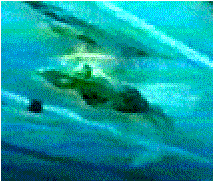HOW CHAMPIONS DO IT
Researched, produced, and prepared by Brent S. Rushall,
Ph.D., R.Psy.

LEISEL JONES AT 30 m OF HER WORLD RECORD SEMI-FINAL 100 m BREASTSTROKE RACE AT THE 2003 WORLD CHAMPIONSHIPS IN BARCELONA
Each frame is .1 seconds apart. Leisel Jones' time for this semi-final race was 1:06.37.
This stroke analysis includes a moving sequence in real time, a moving sequence where each frame is displayed for .5 of a second, and still frames.
The following image sequence is in real time. It will play through 10 times and then stop. To repeat the sequence, click the browser's "refresh" or "reload" button.

The following image sequence shows each frame for half a second. It will play through 10 times and then stop. To repeat the sequence, click the browser's "refresh" or "reload" button.

At the end of the following narrative, each frame is illustrated in detail in a sequential collage.
Notable Features
Frame #1: At the start of the stroke, the swimmer is in perfect streamline, a feature that underlies all stages of her stroke.
Frame #2: Full streamline is maintained while the hands spread apart. There is little pitch to the hands.
Frame #3: Once the hands are more than shoulder-width apart, the hands pitch and commence to "hold" water. The torso, hips, and legs have remained rigidly streamlined in this disciplined stroke position.
Frame #4: The elbows bend and the upper arms medially rotate in a classic manner to commence arm propulsion. The upper back begins to hyperextend while the trailing remainder of the swimmer continues in perfect streamline.
Frame #5: The arm movement continues to pull back and in as the head is raised. The angle of the hand/forearm surfaces possibly generates sufficient vertical force to support the upward movement of the head and shoulders and thus, allows the rest of the swimmer to continue in horizontal streamline. This feature most probably is moderated by Leisel's flat stroke, which from above the water appears to have minimal vertical movement. The power for the pull comes from abduction of the upper arms.
Frame #6: As the upper arms continue through abduction to adduction, the elbows bend more and the pull contains both vertical and horizontal force components. The additional vertical force supports the head in a breathing position and also minimizes the drop of the hips and knees as preparation for the kick commences.
Frame #7: The hands come in under the upper chest. The shoulder-to-hip line remains straight facilitating good water flow along the minimally inclined body. The legs continue to be drawn up but with the feet well apart and ankle dorsi flexion already commencing.
Frame #8: The hands quickly "pray" in preparation for forward recovery. The legs continue to be drawn up with the body and thighs still in very good streamline.
Frame #9: The hips flex and the knees are brought forward and flexed very quickly. Although not visible here, the feet are fully dorsi flexed and everted ready to kick backward. The recovering arms commence forward extension. This action, along with that in the next frame, emphasizes the maintenance of optimal streamline in the total stroke.
Frame #10: Arm recovery is made directly forward (there is no unnecessary vertical movement in this phase of the stroke). The head begins to return after breathing. That movement produces a reaction force that causes the hips to rise. The hip elevation allows the propulsive surfaces of the feet and inner shanks to kick directly backward.
Frame #11: The kick continues to propel directly backward. No propulsive force is lost to lateral or vertical movement components. As the head drops lower into the water, the hips rise even further being assisted by some hyperextension of the lower back.
Frame #12: The kick propels a very streamlined swimmer. The width of the feet at this stage illustrates the need to have the breaststroke kick produce maximal direct propulsive forces.
Frame #13: The full kick is achieved while the swimmer has remained close to perfectly streamlined. The efficiency of water flow past the unproductive body parts of this swimmer is most remarkable.
Frame #14: The legs begin to adduct as the swimmer achieves full streamline.
Frame #15: Full streamline is achieved at the completion of the stroke cycle.
Leisel Jones' stroke is one of the best examples of streamlining in breaststroke this analyst has ever seen. It is well known that her coach has worked on keeping her stroke as low as possible, which seems to be well-justified by the underwater positions and actions of the swimmer. In terms of emphasizing streamline, Leisel Jones is not alone because it is also a remarkable feature of the techniques of Xuejuan Lou (who went on to defeat Leisel in the final of this event) and the top male breaststroker, Kosuke Kitajima. Perhaps, as coaches realize unnecessary and unproductive vertical movements are not of advantage to breaststroke swimmers, Leisel Jones will serve as a very good model.
Another feature of Leisel Jones' stroke is its discipline. It is illustrated by the positioning of her body and trailing legs to produce a flat and tapered object to be propelled by the inertia of the kick and the early arm pull. The point of discipline is that were movements initiated when other parts of the body and legs were moving there is a good chance those movements would be counteracted in some detrimental manner. In this particular race, Leisel Jones was not the fastest at the 50 m turn but was markedly faster than any other swimmer in the second 50 m. A notable comment was made by Leisel's coach, Ken Wood, after her defeat in the final. He described her swimming in terms of technique breakdown -- a "hurried stroke" that possibly would have shown her initiating an arm pull before completion of the kick and body streamline as shown here.

Return to Table of Contents for this section.






